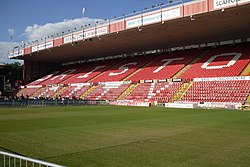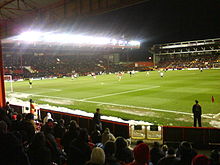Ashton Gate (stadium)
'The Gate' | |
 | |
 | |
| Full name | Ashton Gate Stadium |
|---|---|
| Location | Ashton Road, Bristol BS3 2EJ |
| Coordinates | 51°26′24″N 2°37′13″W / 51.44000°N 2.62028°W |
| Owner | Bristol City Football Club |
| Capacity | 16,600 (27,000 from 2016-17) |
| Field size | 115 x 75 yards |
| Opened | 1887 |
| Tenants | |
| Bedminster F.C. (until 1900) Bristol City F.C. (1904–present) Bristol Rugby (2014–present) | |
Ashton Gate Stadium is a stadium in Ashton Gate, Bristol, England, and is the home of Bristol City F.C. and Bristol Rugby. Located in the south-west of the city, just south of the River Avon, it currently has an all-seated capacity of 16,600, due to redevelopment, which should increase to a capacity of 27,000 by the start of the 2016-17 season of English football.
History and arrangement
Ashton Gate was the home of Bedminster F.C. until their 1900 merger with Bristol South End who played at St John's Lane, and the merged club played at St John's Lane until the end of the 1903–04 season, when they moved to Ashton Gate.[1]

The ground has also played a part in the history of rugby in the city. Bristol Rugby have played there on a number of occasions since the 1920s, the most recent being on 27 December 2006 when they defeated local rivals Bath Rugby 16–6 whilst selling out the stadium for an all-time record Premiership crowd outside of Twickenham. Several rugby internationals have been held, starting with England versus Wales in 1899. 100 years later, the All Blacks took on Tonga in a 1999 Rugby World Cup pool match.
It has hosted two England under-21 international friendlies. The first was against Romania’s under-21’s on August 21, 2007. It ended in a 1 - 1 draw with Matt Derbyshire giving the hosts the lead on the eighth minute but Joe Hart’s 25th minute own goal gifted the visitors a draw but they had Cristian Scutaru sent off on the seventy second minute for a second bookable offence. There were 18,640 in attendance. The other was against Uzbekistan’s under-21’s on August 10, 2010. The hosts beat the visitors 2 - 0 with Danny Rose scoring on the 64th minute and Martin Kelly scoring on the 78th minute. There were 9,821 in attendance.
Former stands
Wedlock "East End" Stand

The old East End was demolished during the summer of 2014 and has been completely rebuilt to modern standards. It was built as a covered terrace in 1928, converted to seats in the 1990s and was the traditional home fans' end until 1994. It was known as the East End to City fans.
Williams Stand
The Williams Stand was on the southwest side, which included the directors' box and press box, and was built in 1958. The lower part of the stand was a terrace known as the Grand Enclosure until it was converted to seating in the 1990s. This stand was also named after a former chairman Des Williams. Demolition of this stand occurred in June 2015 in preparation for rebuilding to modern standards over the course of the next year.
Current stands
Dolman Stand
The Dolman Stand', which lies opposite what was the Williams Stand, was built in 1970. At that time it was built it had a small, flat Family Enclosure in front of it, which was later built up and converted to seating. In the summer of 2007, the original wooden seats in the upper area were replaced by modern plastic seats. It is named after the former club chairman and president Harry Dolman. This stand was redeveloped over the summer of 2015 as part of the redevelopment of Ashton Gate.
Atyeo Stand
The Atyeo stand was built in 1994 to replace an open terrace, and contains new dressing rooms and a large gymnasium. It is named after Bristol City legend John Atyeo, who played 645 times for City and scored 351 goals, making him the club's top goalscorer ever. He died in 1993, a year before the new stand opened. After the demolition of the Wedlock Stand, the north-east section of this stand is used to house the away fans. Once the construction of the new West Stand is completed, away fans will be situated in the Western three-quarters of the Atyeo Stand. For cup matches, this can be extended,to the whole of this stand.

South Stand
The South Stand was completed just after the end of the 2014-15 season as part of the redevelopment of Ashton Gate. It has a capacity of 6,071 and is all-seater. Unlike the other two stands at Ashton Gate, it is not named after a person who had strong ties with the club. The stand is linked to the neighbouring Dolman Stand via a concourse, and will eventually also be linked with the new West Stand.
Redevelopment of Ashton Gate
Following extensive planning and the failed bid to develop a new ground at Ashton Vale, and criticism of the failure of so many major leisure and sporting projects in Bristol,[2] Bristol City finally decided to press ahead with a major redevelopment of the current site at Ashton Gate.[3] This was approved in late 2013, with final clearance given in spring 2014, and work started in May 2014, following the final home fixture of the 2013-14 season.
The plans for redevelopment were as follows:
- Demolition of the existing Williams and Wedlock (East End) stands, to be replaced by new, larger stands, with executive boxes.
- Extension of the existing Dolman stand
- Shifting of the current pitch by 5 metres to enable the Dolman extension, and a new pitch laid to enable shared use with the rugby club
- Other works to the ground to bring it in line with modern stadia, with capacity of around 27,000
The works are planned to be completed by the start of the 2016-17 season.
So far, the phases completed are the demolition of the Wedlock Stand, the building of the new South Stand in place of the old Wedlock Stand, the extension of the existing Dolman stand, a newly-laid pitch and the demolition of the former Williams Stand. The only phase that is yet to be completed is the construction of a new stand in place of where the old Williams Stand once stood, which will be completed over the course of the 2015-16 season. It is anticipated that once the construction of the new West Stand is completed, away fans will be situated in the entirety of the Atyeo Stand.
Other uses
Rugby matches
Ashton Gate is now the home of not only Bristol City but Bristol Rugby as well, after moving in, in August 2014.
Ashton Gate has also held two international rugby union matches, as follows:
| Date | Competition | Home team | Away team | ||
|---|---|---|---|---|---|
| 18 January 1908 | 1908 Home Nations Championship | England | 18 | Wales | 28 |
| 3 October 1999 | 1999 Rugby World Cup, Pool 2 | New Zealand | 45 | Tonga | 9 |
Ashton Gate has held one rugby league tour match[4] , as follows:
| Date | Competition | Home team | Away team | ||
|---|---|---|---|---|---|
| 20 December 1911 | 1911/12 Kangaroo Tour | Wales & West | 3 | Australia | 23 |
Music
Ashton Gate has played host to music concerts, including those of The Who, The Rolling Stones, Bryan Adams, Bon Jovi and Elton John.[5]
See also
References
- ^ Paul Smith & Shirley Smith (2005) The Ultimate Directory of English & Scottish Football League Grounds Second Edition 1888–2005, Yore Publications, p16, ISBN 0954783042
- ^ "Why does Bristol never build anything?". BBC News. 16 January 2014.
- ^ "It's all kicking off as work starts on £40m makeover for Bristol City stadium". Bristol Post. 28 April 2014.
- ^ Shawn Dollin and Andrew Ferguson (1 February 2015). "Kangaroos Tour 1911/12". rugbyleagueproject.org.
- ^ "Sir Elton comes to Bristol". BBC Bristol. BBC. 10 December 2003. Retrieved 30 July 2012.
